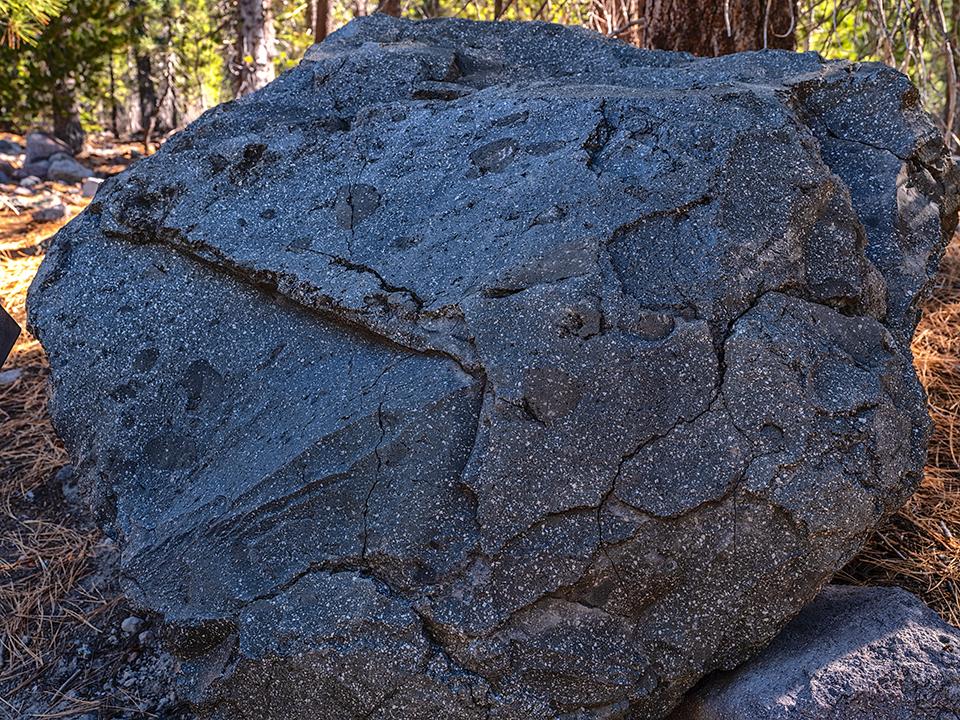
Just what are those round inclusions called in this dacite boulder found in the Devastated Area of Lassen Volcanic National Park? / Rebecca Latson
I’m always learning something new about the units within the National Park System. Hopefully, you learn something new, too. Test your national park knowledge with this latest quiz piece before checking the answers at the bottom.
1. If you’ve ever visited the Devastated Area of Lassen Volcanic National Park in California, you’ll have seen this boulder alongside the trail. The boulder is dacite, a volcanic rock that is predominate in the park. Those round-ish, finer-grained splotches you see in the boulder are basalt, another volcanic rock. These basalt splotches are called ___.
a) Globular spherules
b) Quenched blobs
c) Basalt globs
d) Intrusive pyroclasts

A red fox walking the road in Denali National Park and Preserve / NPS - Claire Abendroth
2. Many national parks, like Denali National Park and Preserve, are habitats for the red fox. “As winter approaches, red foxes grow thick winter fur highlighted by a voluminous, white-tipped tail known as a ___.
a) Brush
b) Sweep
c) Dock
d) Swatter
3. When hiking along any of the trails at Buffalo National River, you may take notice of the sassafras tree. The easiest way to identify it is by their leaves. Sassafras trees have ___ leaves.
a) Multicolored
b) Serrated
c) Silver-edged
d) Polymorphic
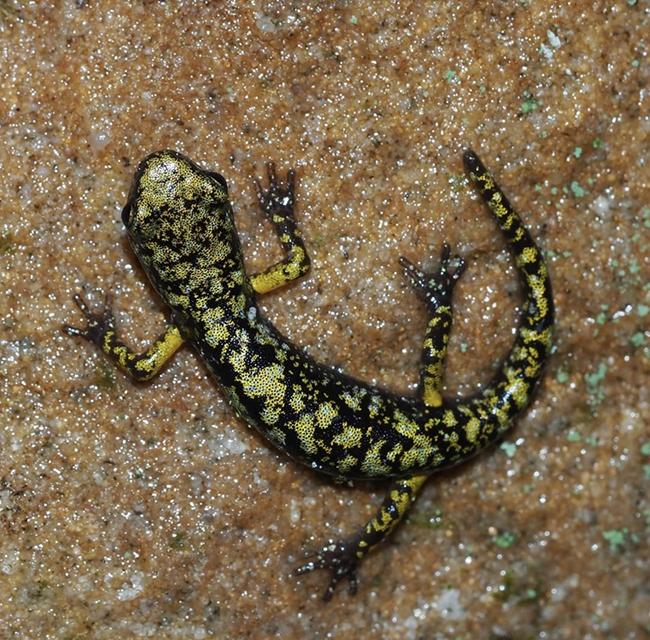
Green Salamander, New River Gorge National Park and Preserve / Clay Gibbons via NPS Instagram
4. Hike a trail near a cliff at New River Gorge National Park and Preserve and you may come across a beautifully-patterned green salamander (Aneides aeneus). True or False: Green salamanders are lungless.
a) True
b) False

Mountain bluebird, Bandelier National Monument / NPS
5. While hiking at Bandelier National Monument, you might spy a beautiful Mountain bluebird in the trees. Mountain bluebirds are ___ nesters.
a) Cavity
b) Empty
c) Boulder
d) Treetop
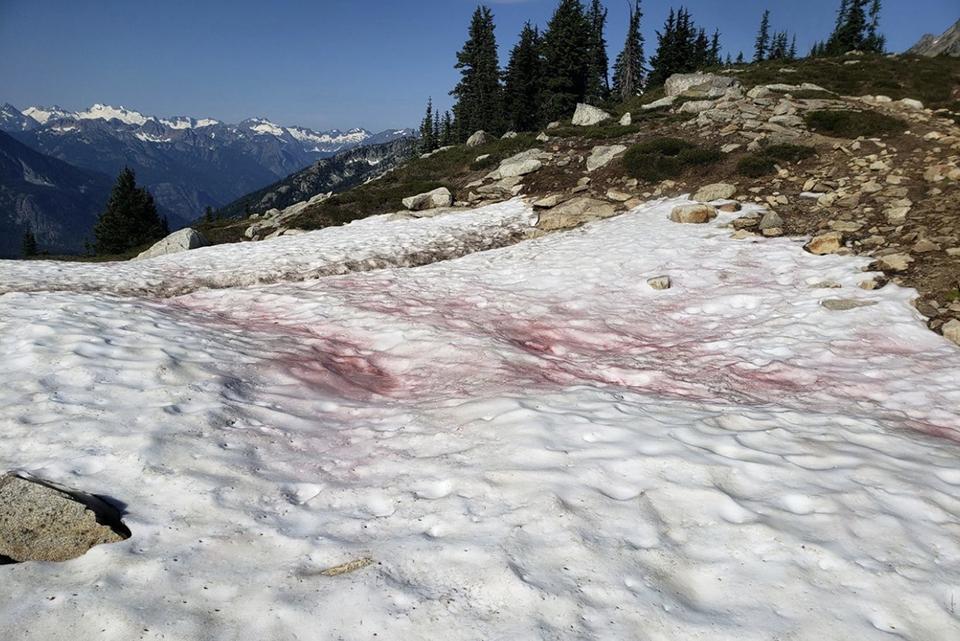
Watermelon snow, North Cascades National Park / NPS - D. Mailman
6. While hiking a high-elevation trail in the spring or early summer at someplace like Glacier National Park or North Cascades National Park, you might see patches of red and pink on the surrounding snow. Called watermelon snow, these colorful patches can actually smell like watermelon. True or False, watermelon snow comes from red algae.
a) True
b) False

A grasshopper fossil, Fossil Butte National Monument / NPS
7. The image above is a fossil grasshopper found at Fossil Butte National Monument in Wyoming, location of “some of the world’s best-preserved fossils.” Scientists can tell this fossil is a grasshopper based upon ___.
a) Thorax segmentation
b) Wing venation
c) Pronotum identification
d) Eye size
8. A walk along the trails of Sequoia and Kings Canyon National Parks will take you through thick forests of many tree species in addition to the signature giant sequoia: white fir, incense cedar, sugar pine, red fir, and ponderosa pine, for instance. How do scientists determine if a tree is healthy?
a) Exploratory dissection
b) Bark fragrance
c) Fascicle bundles
d) Leaf color
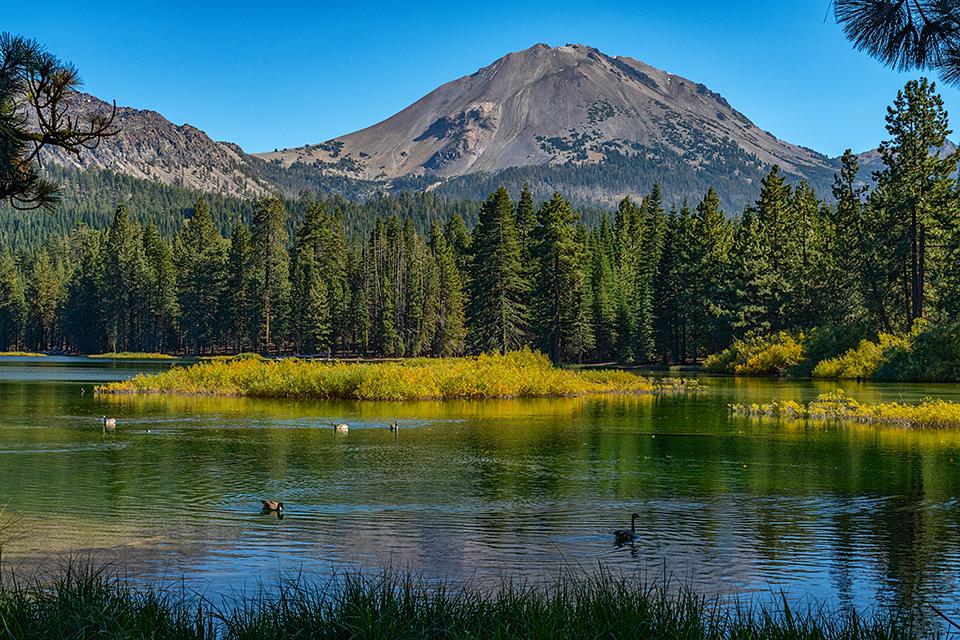
A view of Lassen Peak from Manzanita Lake, Lassen Volcanic National Park / Rebecca Latson
9. Lassen National Park is one of the few national parks to showcase all four types of volcano: cinder cone, strato, shield, and ___.
a) Composite
b) Plug dome
c) Conical
d) Tephra

A white-tailed deer fawn, Tallgrass Prairie National Preserve / NPS
10. Tallgrass Prairie National Preserve has “over 500 species of plants, nearly 150 species of birds, 39 species of reptiles and amphibians, and ___ species of mammals.”
a) 18
b) 25
c) 31
d) 47
Trivia
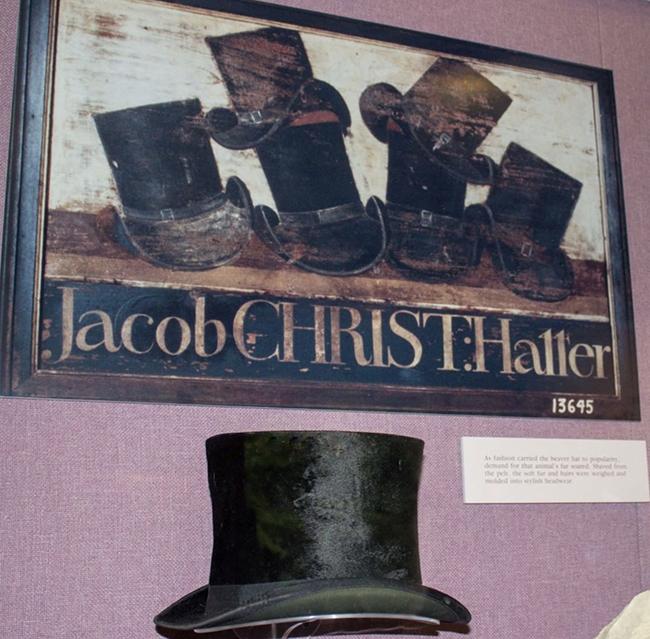
A beaver top hat and exhibit at the visitor center of the Lewis and Clark National Historical Park / NPS
During the time of the Lewis and Clark Expedition, the fur trade was a powerful and lucrative business, with beaver pelts as the “primary material of the day … The furs were in demand to make the must-have accessory of the era, the beaver felt top hat. To construct one of these hats, a hatter used felt made from the fine undercoat of the beaver. The felt was waterproof, durable, and held its shape, making it an ideal material for hat making.” Because this was a must-have for the well-dressed gentleman, a single beaver pelt could go for as much as $100. “For context, the enlisted men of the Lewis and Clark Expedition got paid on average $5 a month.”
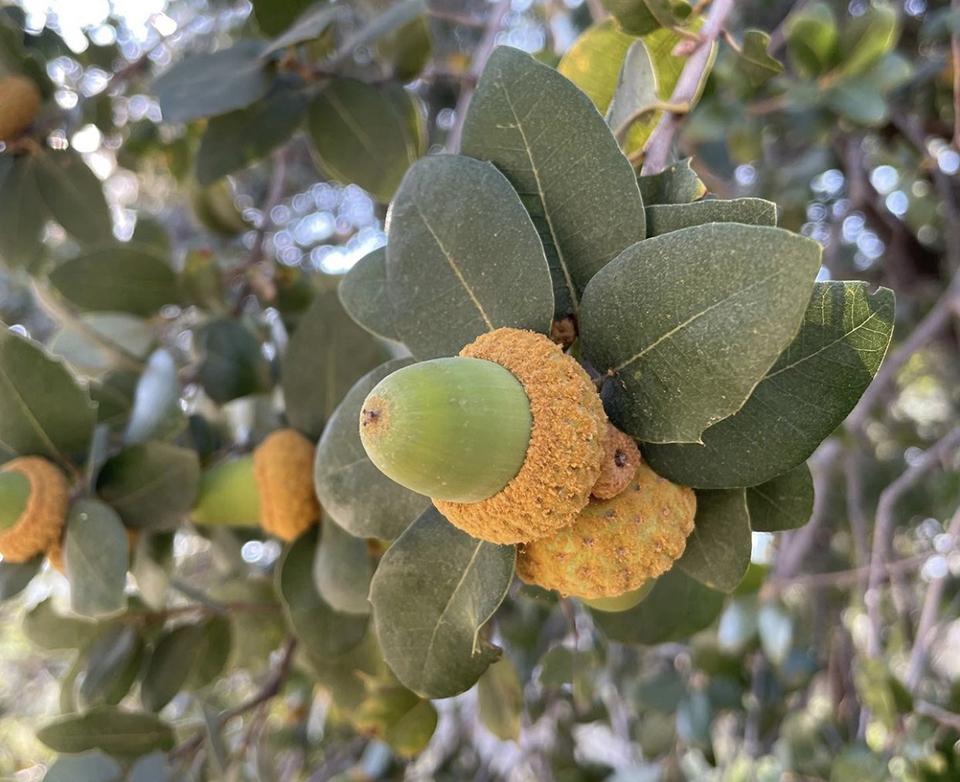
Fuzzy golden acorns on the branches of the canyon oak tree, Whiskeytown National Recreation Area / NPS
Pictured above are acorns of the canyon oak tree, also called the golden-cup live oak. You might see these lovely, fuzzy acorns while hiking around Whiskeytown National Recreation Area. “This species of evergreen oak tree is exceptionally drought tolerant and is known to vigorously sprout new shoots from the base of the trunk after a wildfire.” You can find these oak trees and their acorns close to the Guardian Rock Trail near Horse Camp Primitive Campground.
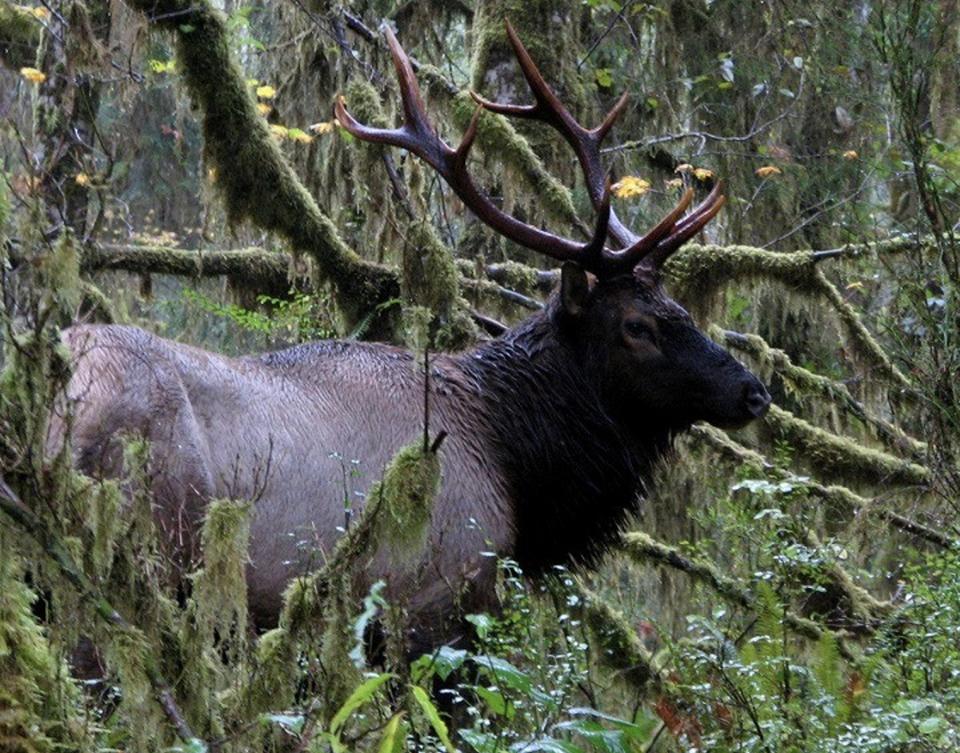
A male Roosevelt elk, Olympic National Park / NPS
“Roosevelt elk have lived alongside humans on the Olympic Peninsula since time immemorial. In the early 20th century, Olympic National Park was created with the specific goal of protecting habitat for these magnificent animals. Today, the national park is home to the world’s largest population of Roosevelt elk. Fall is run (breeding) season for elk.” A visit to Olympic National Park at this time means you might have the opportunity to see these elk, with sightings “most common at dusk and dawn in Olympic’s lower valleys and rain forests.” If you do see elk, please keep a safe distance of at least 150 feet (50 meters) away from them. If you encounter elk on a trail, make noise, avoid eye contact, and move away slowly. During rut, bull elk can get mighty cantankerous.
Answers
1b
Quenched blobs are formed during the rock’s molten stage, when basalt magma mixes with dacite magma. Dacite magma is much cooler than basalt magma, and when the basalt magma is injected into the dacite magma, it’s like “hot wax hitting cold water,” and the hot basalt blobs are quenched, solidified, and encased in the dacite.
2a & b
A fox’s white-tipped tail is known as either a brush or sweep. “They shed this fur at the beginning of spring, reverting to shorter fur during the summer months." To learn more about the red fox, click here.
3d
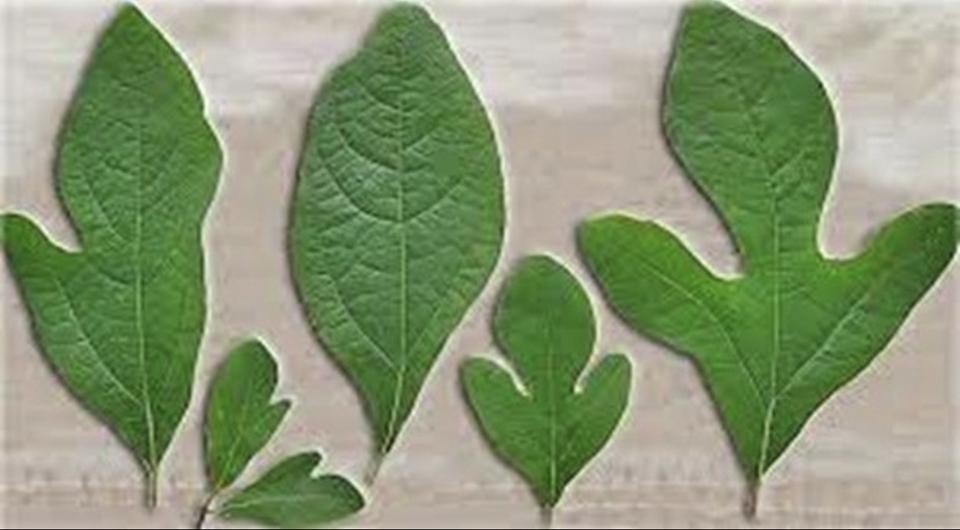
Sassafras leaf patterns left to right: mitten, oval, three-lobed, Buffalo National River / NPS
Sassafras trees have polymorphic leaves, meaning that a single tree can have leaves of different shapes. The leaves on the sassafras can be oval, mitten-shaped, and three-lobed. The leaves and twigs also have a sweet smell. In the spring, you will find before the leaves appear, the sassafras has little yellow flowers that have a very fragrant smell.
4a True
Green salamanders “are members of the lungless salamander group, meaning they breathe through their skin rather than with lungs. The titular green, lichen-like patterning on their backs sets them apart from nearly all other salamanders in North America.” In addition to loving the cliff areas of the gorge, green salamanders are believed to also use dead logs and bark as a source of shelter.
5a
Mountain bluebirds are cavity nesters. “They rely on cavities excavated by other birds, like woodpeckers, and arrive to nesting sites early to choose the best ones. The male might be a flashy partner, but, for the slightly more drab female, mate selection is all about location, location, location. She chooses the male who can offer her the best nest site.”
6b False
Watermelon snow’s vivid pink is a result of green algae. “It’s part of a group called Chlorophyta, a snow algae – and is found worldwide in mountains and polar regions. As the snow melts, the algae ‘blooms’ and develops its red pigment for sun protection.” P.S. watermelon snow may smell like watermelon, but it definitely does not taste like watermelon and can give you a stomach ache or other “digestive” ailments.
7b
Paleontologists are able to tell the fossil in the image is a grasshopper based on wing venation (the structure of the veins within the wings).
8a
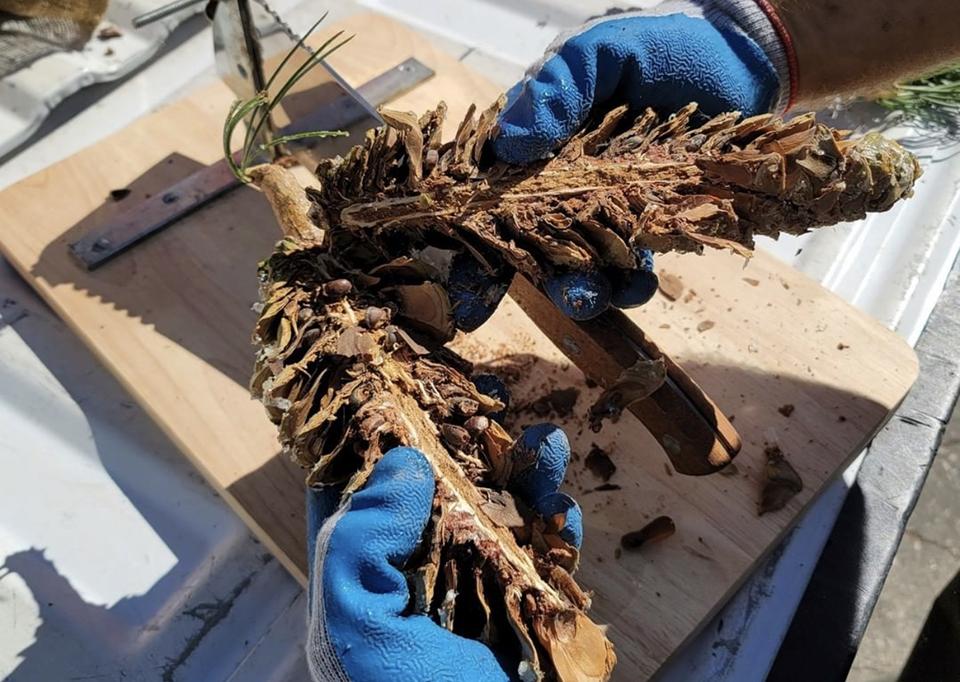
Exploratory dissection of a sugar pine cone, Sequoia and Kings Canyon National Parks / NPS
One way to determine a tree’s health is to perform exploratory dissection (cutting into them). In the image above, the “impromptu surgeon assessed its reproductive health by retrieving a fresh cone from a sugar pine and cut it apart to examine the inside. The prognosis was not ideal: insect larvae, likely sugar pine cone beetle (Conophthorus lambertianae) had devoured most of the seeds, and few viable seeds were left. In a fully healthy tree, the cone will produce resin to expel hungry insects.”
9b
Ok, this one was a gimme, I know. But it’s pretty cool that Lassen Volcanic National Park has all four types. Lassen Peak is considered one of the largest plug dome volcanoes in the world. Hike the Cinder Cone Trail and you’ll find yourself atop a cinder cone with fantastic views. Prospect Peak is an example of a shield volcano, and Brokeoff Volcano is a strato (composite) volcano. To learn more about the volcanoes of this national park, click here.
10c
The list of species found at Tallgrass Prairie National Preserve includes 31 mammals. To learn more about the nature and science of Tallgrass, click here.



Add comment